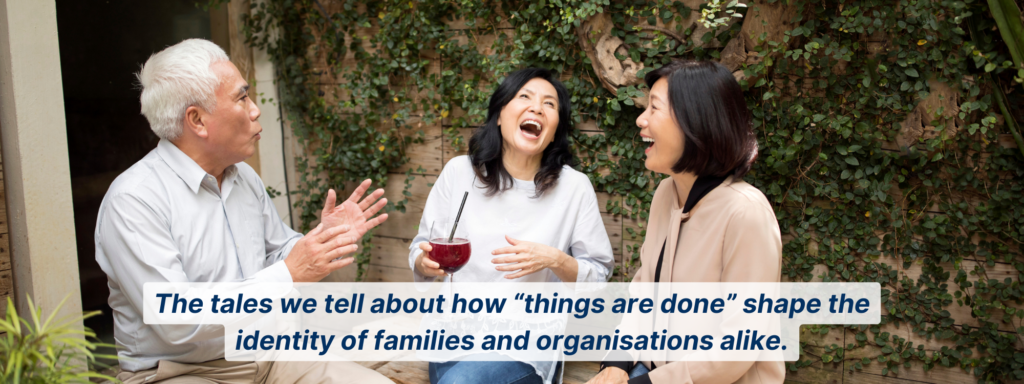Humans are storytellers at heart. Whether it’s bedtime tales for children or sharing a laugh over dinner with friends, stories are how we make sense of the world. They help us understand life, pass down wisdom, and strengthen relationships. From families to workplaces, storytelling is a powerful tool for navigating challenges, preserving traditions, and shaping culture. Here’s how you can use the magic of storytelling to connect with children, friends, colleagues, and more.
Why Stories Matter
Stories are how we make sense of life’s complexities. Faced with uncertainty or confusion, we instinctively build narratives that help us understand and act. Whether in a bustling household or a fast-paced workplace, storytelling cuts through the noise, offering clarity and connection.
Stories in Families
Children naturally respond to stories—they’re a window to understanding the world. A simple tale about a kind fox sharing food teaches empathy, while stories of overcoming challenges inspire resilience. When families face big changes, like moving to a new city, framing the experience as an exciting adventure rather than a disruption can ease anxieties and build excitement.
Even within a family’s daily life, storytelling captures priceless wisdom. How Grandma calmed a crying baby or the best way to organise a holiday feast—these are treasures passed through stories. Sharing these tales helps preserve traditions and guides younger generations in their own journeys.
Stories with Friends and Colleagues
A good story can deepen relationships and build trust. Sharing a personal struggle and how you overcame it fosters empathy and respect. In the workplace, stories help teams navigate tricky dynamics. Instead of focusing on conflicts or setbacks, leaders who frame challenges as opportunities for learning create a culture of growth and collaboration.
Storytelling also captures the wisdom that can’t be written in manuals. A retiring colleague’s anecdote about handling a difficult client conveys far more insight than a checklist ever could. Encourage informal story-sharing over team lunches or during reflection sessions to keep valuable knowledge alive.
Using Stories to Navigate Complexity
In life’s messiest situations, stories are a compass. They help us see patterns, understand perspectives, and adapt to change. A family dealing with divorce or job loss can use storytelling to reframe the experience. Instead of focusing on loss, presenting it as a chapter in a larger story of resilience and growth can bring comfort and hope. Similarly, a failed project isn’t just a setback—it’s a chapter in the organisation’s learning journey. Leaders who frame failures as stepping stones to innovation inspire teams to push forward with creativity and determination.

Shaping Culture Through Stories
Stories don’t just reflect values—they define them. The tales we tell about how “things are done” shape the identity of families and organisations alike. A story about Grandpa working three jobs to provide for his family instils values of perseverance and gratitude. These narratives become part of the family’s identity, guiding generations. Also, pay attention to the stories circulating in your organisation. Are they about teamwork and innovation, or control and hierarchy? Leaders can craft new stories that inspire alignment with shared goals and spark cultural change.
Practical Storytelling Techniques
Here are some simple, effective ways to use storytelling to strengthen relationships and foster understanding:
- Family Dinner Stories: Encourage everyone to share a favourite memory. This builds connection and surfaces shared values.
- Daily Highlights: Ask children to share “the best thing that happened today.” It creates positive memories and strengthens bonds.
- Team Anecdotes: Create space for colleagues to share personal experiences or lessons learned. This fosters collaboration and preserves tacit knowledge.
- Reframing Challenges: Whether it’s a tough day at work or a family struggle, use stories to highlight resilience and shared purpose.
How Stories Transform Lives
When used intentionally, stories can improve every aspect of life:
- Better Communication: Complex ideas become relatable and memorable.
- Deeper Connection: Sharing personal stories builds trust and understanding.
- Stronger Cultures: Stories align people around shared values and goals.
- Smarter Decisions: Narratives provide context, helping us weigh choices more thoughtfully.
Making Storytelling Part of Your Daily Life
- At Home: Use bedtime stories to teach values or celebrate family traditions through shared memories.
- At Work: Share stories that inspire your team and capture valuable lessons.
- With Friends: Build connection through shared experiences and heartfelt anecdotes.
 Final Thoughts
Final Thoughts
Stories are the threads that weave our lives together. They help us understand, connect, and grow. Whether you’re tucking in a child, chatting with friends, or leading a team, storytelling is your bridge to deeper connection and shared understanding. By making stories a part of your daily life, you can inspire those around you, preserve what matters most, and create a legacy of growth and resilience.


 Final Thoughts
Final Thoughts

